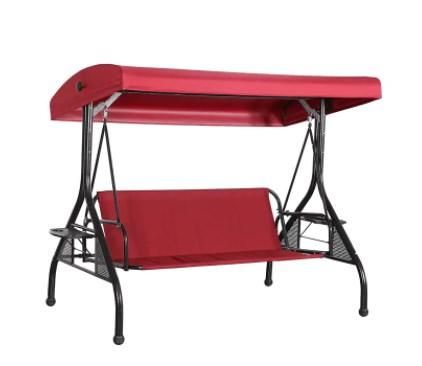Outdoor swing glider chair, often cherished for their serene comfort and leisurely sway, are favored additions to any outdoor setting. But as they weather the elements, questions arise about their durability and protection against nature's forces. One of the key inquiries often posed is whether these chairs come equipped with waterproof or sunproof capabilities.
To unravel this query, it's essential to delve into the design and construction of outdoor swing glider chairs. These chairs are typically crafted with materials chosen for their resilience against outdoor conditions. Common choices include weather-resistant wood varieties like teak or cedar, corrosion-resistant metals such as aluminum, and synthetic materials like resin or polyethylene wicker.
The quest for waterproof features begins with material selection. Many manufacturers opt for materials inherently resistant to moisture, such as naturally water-repellent woods or synthetic fibers designed to withstand rain and humidity. Additionally, specialized treatments or finishes may be applied to enhance water resistance, forming a protective barrier against moisture intrusion.
Furthermore, the construction of outdoor swing glider chairs plays a pivotal role in determining their waterproof properties. Tight joints, sealed seams, and strategic design elements contribute to minimizing water penetration. For instance, chairs may feature slatted seats or perforated surfaces to allow water to drain quickly, preventing pooling and potential damage.
In parallel, the concern shifts towards sunproof attributes. Exposure to UV radiation can cause fading, deterioration, and discomfort over time. Manufacturers address this by integrating UV-resistant coatings or treatments into the materials or finishes used in crafting outdoor swing glider chairs. These coatings act as a shield, deflecting harmful UV rays and prolonging the chair's aesthetic appeal and structural integrity.
Moreover, the design considerations extend beyond material selection and treatments. Strategic placement of the chair in outdoor spaces can also enhance its sunproof capabilities. Positioning the chair in shaded areas or under canopies provides additional protection from direct sunlight, reducing exposure and mitigating the risk of sun damage.
In addition to proactive measures taken during manufacturing and design, maintenance practices play a crucial role in preserving the waterproof and sunproof qualities of outdoor swing glider chairs. Regular cleaning with mild detergents and water helps remove dirt, debris, and environmental pollutants that can compromise protective coatings or finishes.
Furthermore, periodic inspections allow for the timely detection of any wear or damage, enabling prompt repairs or refurbishments to uphold the chair's performance and longevity. Additionally, storing the chairs indoors or covering them with weatherproof furniture covers during extended periods of inclement weather or non-use can provide an extra layer of protection against the elements.
In conclusion, while outdoor swing glider chairs are renowned for their inviting comfort and gentle sway, their resilience against the elements is equally crucial. Through meticulous material selection, thoughtful design, and proactive maintenance, manufacturers imbue these chairs with waterproof and sunproof capabilities, ensuring they remain steadfast companions in outdoor relaxation for years to come.



